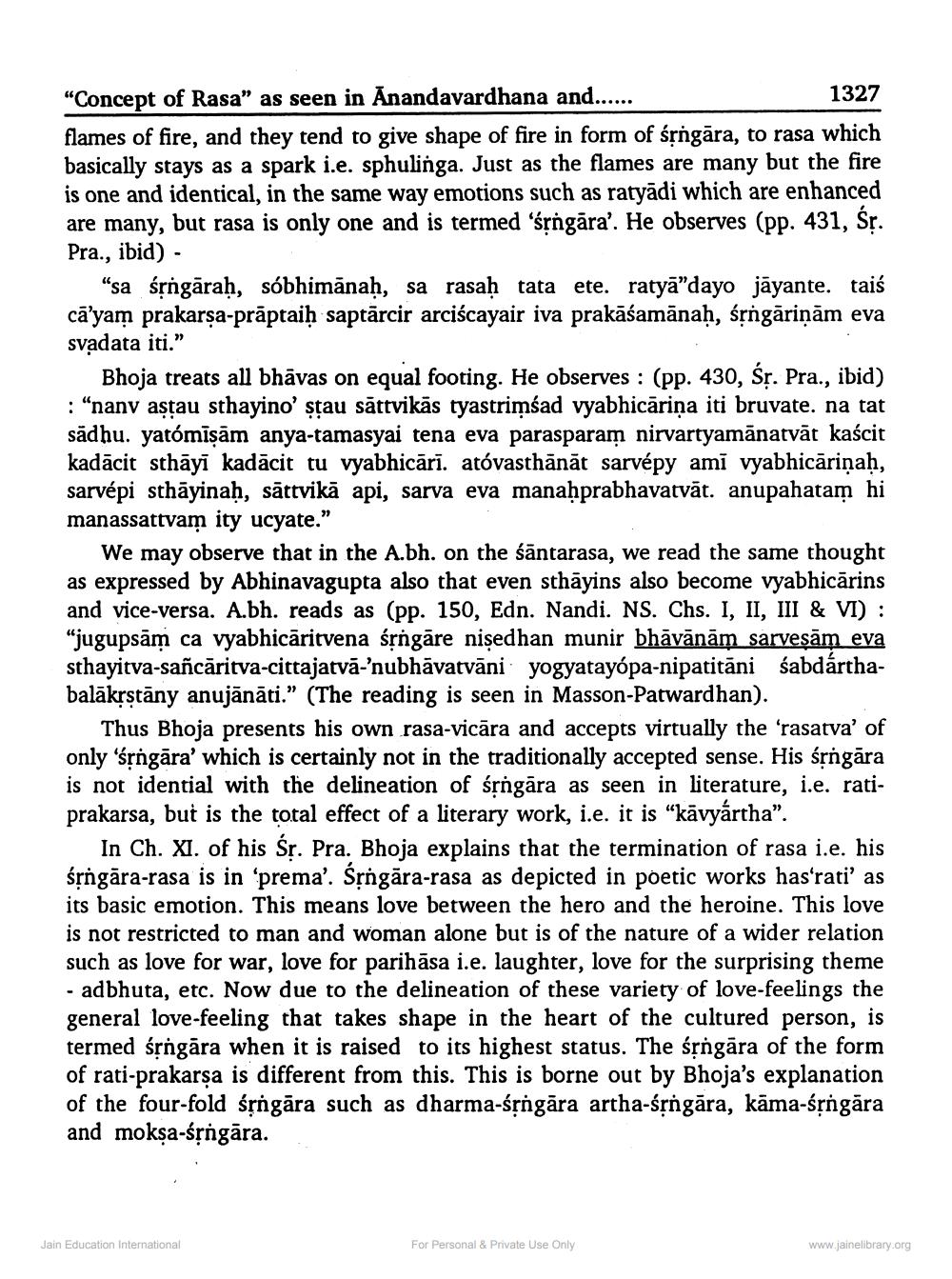________________
“Concept of Rasa” as seen in Anandavardhana and......
1327 flames of fire, and they tend to give shape of fire in form of śộngāra, to rasa which basically stays as a spark i.e. sphulinga. Just as the flames are many but the fire is one and identical, in the same way emotions such as ratyādi which are enhanced are many, but rasa is only one and is termed 'śrngāra'. He observes (pp. 431, Śr. Pra., ibid) -
"sa śộngāraḥ, sóbhimānaḥ, sa rasaḥ tata ete. ratyā”dayo jāyante. taiś cā’yam prakarsa-prāptaiḥ saptārcir arciścayair iva prakāśamānaḥ, śộngāriņām eva svadata iti."
Bhoja treats all bhāvas on equal footing. He observes : (pp. 430, Śr. Pra., ibid) : “nanv aştau sthayino' stau sātrvikās tyastrimsad vyabhicāriņa iti bruvate. na tat sadhu. yatomisām anya-tamasyai tena eva parasparam nirvartyamanatvat kaścit kadācit sthāyī kadācit tu vyabhicārī. atóvasthānāt sarvépy ami vyabhicāriņaḥ, sarvépi sthāyinah, sāttvikā api, sarva eva manaḥprabhavatvāt. anupahatam hi manassattvam ity ucyate.”
We may observe that in the A.bh. on the śāntarasa, we read the same thought as expressed by Abhinavagupta also that even sthāyins also become vyabhicārins and vice-versa. A.bh. reads as (pp. 150, Edn. Nandi. NS. Chs. I, II, III & VI) : “jugupsām ca vyabhicāritvena śộngāre niședhan munir bhāvānām sarveşām eva sthayitva-sañcāritva-cittajatvā-'nubhāvatvāni yogyatayópa-nipatitāni śabdárthabalākrstāny anujānāti.” (The reading is seen in Masson-Patwardhan).
Thus Bhoja presents his own rasa-vicāra and accepts virtually the 'rasatva' of only 'śrngāra' which is certainly not in the traditionally accepted sense. His śrngāra is not idential with the delineation of śrngāra as seen in literature, i.e. ratiprakarsa, but is the total effect of a literary work, i.e. it is "kāvyártha".
In Ch. XI. of his Sr. Pra. Bhoja explains that the termination of rasa i.e. his śộngāra-rasa is in 'prema'. Sủngāra-rasa as depicted in poetic works hasérati' as its basic emotion. This means love between the hero and the heroine. This love is not restricted to man and woman alone but is of the nature of a wider relation such as love for war, love for parihāsa i.e. laughter, love for the surprising theme - adbhuta, etc. Now due to the delineation of these variety of love-feelings the general love-feeling that takes shape in the heart of the cultured person, is termed śạngāra when it is raised to its highest status. The śộngāra of the form of rati-prakarsa is different from this. This is borne out by Bhoja's explanation of the four-fold śrngāra such as dharma-śrngāra artha-śrngāra, kāma-śrngāra and mokşa-śộngāra.
Jain Education International
For Personal & Private Use Only
www.jainelibrary.org




